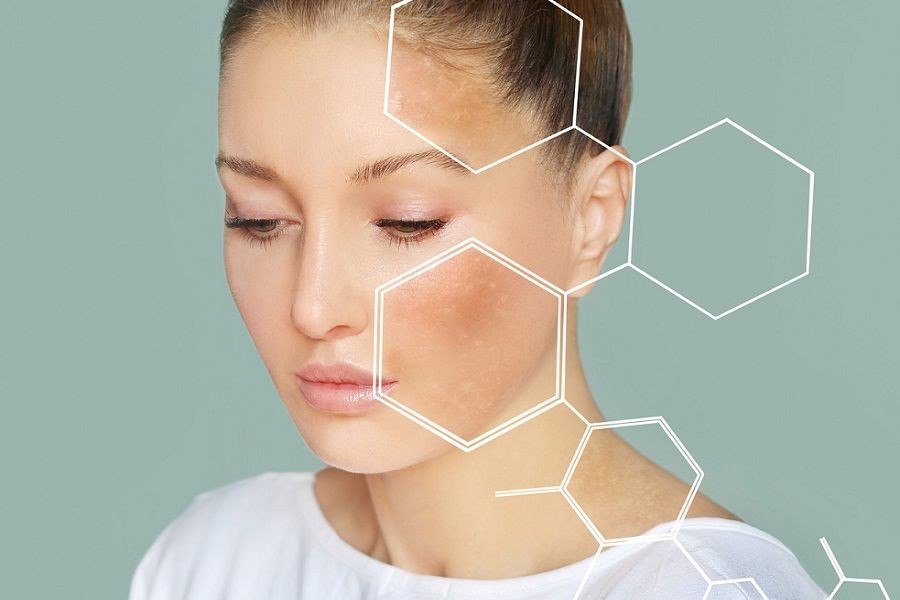Chloasma requires hyper melanosis of sun-exposed areas that occurs mostly during pregnancy and can affect 50 to 70 per cent of pregnant women. Chloasma is often called the mask of pregnancy.
It looks like brownish pigmentation occurs, especially on the central part of the face, like the nose, cheeks, forehead, and sometimes the upper lip portion. However, its frequency is not much high.
Causes of chloasma
Chloasma is thought to be due to the stimulation of pigment-producing cells by female sex hormones so that they produce more melanin or dark-coloured pigments when the skin is exposed to the sun's UV rays. Age, genetics, hormone, thyroid disease, and other medications can be the reason for chloasma.
Melasma or chloasma may start at any point in pregnancy. Mostly it begins in the second or third trimester. These are different from normal hyperpigmentation patches as they are larger and bilaterally symmetrical. These are not harmful to the body and normally go away after pregnancy, but sometimes the patches are stubborn.
Dr Sravya C Tipirneni, Consultant Dermatologist, Cosmetologist and Trichologist at Manipal Hospitals in Bangalore, India, shared how to deal with chloasma during pregnancy in an interview with our writer.
"Chloasma is just a cosmetic issue for a pregnant woman and has no connection to the health of the baby and mother. We cannot diagnose specific reasons for every pregnant woman.
But we can check the thyroid level which can be one of the reasons for it."
"Sunlight can also trigger chloasma and make the patches expand more. To deal with the darker patches, we recommend using some safe fruit extracts that can lighten it."
Ingredients safe for use
Dr. Sravya recommends some ingredients as a topical treatment of chloasmas, such as using vitamin-c, kojic acid, lactic acid, arbutin, liquorice extract, or glycolic acid. These are safe to use during pregnancy and breastfeeding as these are just some fruit extracts.
UV rays can increase chloasma. So it is necessary to use an SPF cream or a physical sunscreen so that UV rays cannot enter the facial layers.
Cleanser and serum
Cleansers can deeply clean the skin and help to reduce the pigmentation from deep layers. Serums with vitamin C can control the excess melanin production of our skin as it penetrates much deeper than a plain moisturiser.
"Patients with chloasma during pregnancy can use niacinamide or glycolic acid-based face cleanser as these suit all skin types. They can use a serum with niacinamide or alpha-arbutin once or twice a day," Dr. Sravya suggested.
Ingredients to avoid
"Kligman's regimen triple combination formula has been one of the most popular treatment options in melasma or hyperpigmentation over the last three decades. The combination is made with tretinoin, a vitamin A derivative, fluocinolone, and hydroquinone. Hydroquinone and fluocinolone are bleaching and lightening agents; they work well to reduce patches and redness. However, these ingredients are unsafe to use during pregnancy."
"Mostly we try alternate ways to reduce chloasmas, such as safe ingredients and laser treatment," said Dr. Sravya.
However, the combination mentioned above is used only when all the possible treatments fail, the patches are too stubborn, and after the mother stops breastfeeding.
Safe face creams or moisturisers
According to Dr Sravya, to own healthy skin, we need to maintain the skin's hydration level for all skin types. Aloe vera and hyaluronic acid mixed with other ingredients is a common combination that works on all skin types.
If someone's skin is too dry, they can use a cream with ceramides or squalene. However, cream-based moisturisers are not suitable for oily and acne-prone skin types. This can promote excess sebum production, clog the pores, and can cause more acne. Only gel or aqua-based products can be good for hydrating oily skin.
Harmful during pregnancy
"There are a lot of ingredients that should be avoided during pregnancy. I am mentioning some of the most harmful ingredients for a caring mother as these can cause harm to the baby. Tranexamic acid, retinol, salicylic acid, and hydroquinone affect the baby," advised Dr Sravya.
She suggested that every pregnant woman must consult a dermatologist for the right product and ingredient to recover chloasma. She encourages to remain patient as safe ingredients require more time to reduce the dark patches.


